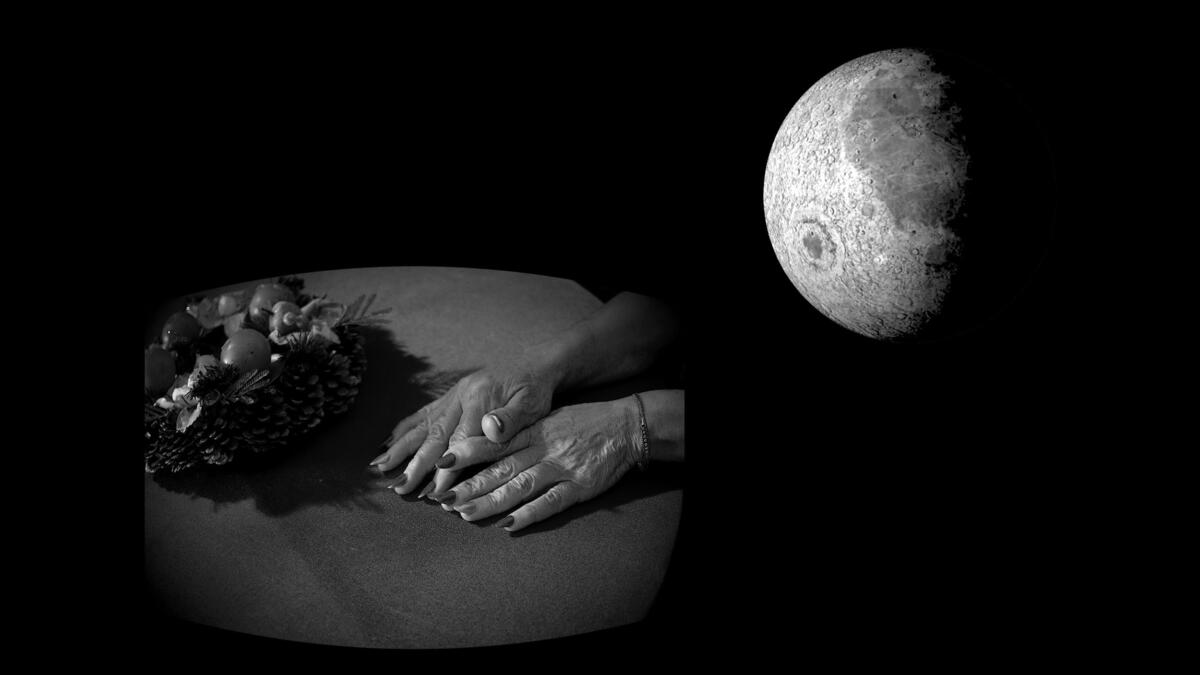
In the midst of the pandemic and the feeling of futurelessness it has brought alongside political and economic crisis, curators Maria Veits and Stanisław Welbel discussed changing scenarios of the futures and unhealed wounds of the past that keep reminding about themselves. The point of departure for this email conversation were the exhibitions Cosmos Calling! (2014) and Off to Space: Counternarrating the Cosmos (2020), that Stanisław and Maria curated in Poland and Israel, respectively. Focusing on space exploration as a platform for artistic and political imaginary, the curators talked about the utopias of the past, humanity’s dreams and artistic strategies of creating alternative futures from non-dominant perspectives in the context of the Cold War and today’s time of confusion and shifting political horizon.
There have been so many exhibitions about cosmos in the recent few years, it seems that the space has a revival when it comes to interests and research of artists and curators. What is the reason for that?
Maria Veits: There are a few reasons for the return of Cosmos and space discourse in the art domain. First, the new spiral turn of the space race, which now has many more participants than during the Сold War, and the way it mirrors the confrontations between countries with strong and growing economies through recent developments of long-existing or newly emerging space programs. Growing surveillance, digital control and drone warfare and the transformations bring into the sociopolitical fabric instigate artistic research and artistic collaborations with technological industry and scientific institutions, where art and technology merge into new formats of cognitive and analytical approach to investigating hidden processes of our technocratic society. Also, the 50s anniversary of the first man on the Moon last year stimulated revisiting 20’s century utopias and redrafting future perspectives, something that is especially relevant in the times of political and environmental crisis at the backdrop of the COVID pandemic, when the future is again very blurry and unpredictable. Plus the revival of the interest to the philosophy Russian cosmism, instigated by Boris Groys and his research of the cosmist ideas about immortality and resurrection of the dead, space colonization and totality of biopower produced by alliance of art and politics. In addition, more archival information and knowledge related to the space race of the Cold War era becomes more available, and together with historians and archivists, artists rediscover bits of history trying to create counternarratives and more inclusive picture of the past that had been inaccessible for many years due to state ideology or enforced confidentiality.

‘Cosmos Calling! Art and Science in the Long Sixties’, at Zachęta National Gallery in Warsaw, 2014, exhibition view.
Stanisław Welbel: Another reason worth mentioning is that the further we get from the past the more blurred and more idealized vision of it we might have. In this sense, the Space Race is not seen as a Cold War front, with political meaning and military objectives but is rather perceived as a romantic endeavour, which it also was, but the accents of what we see in the past are becoming different. The perspective is both informed by nostalgia and current disillusionment with the Space – which become a resource of few companies and start-ups rather than the great Unknown, which belongs to everyone and no one, a borderless place out of any authority. Revisiting the utopias from the Cold War era has today also another significant meaning: the so-called Doomsday Clock from the Cold War times, was ticking faster and faster due to the threat of nuclear Armageddon, today we live in a world that literally ends in front of our eyes – due to the human activity resulted climate changes. Such a bleak perspective inspires searching for space colonies or alternative planets as places to escape.
The story of the Soviet Space programme is so captivating as it enables to rethink the status quo of power balance. It questions the division between the West and the East, delivers a strong narrative, which builds a common ground for the whole former Eastern European block while it remains (which is rare) a peaceful story, a counterbalance for the history of wars and battles. It encapsulates identity issues, science, technology, design and art. Last it was so much present in the visual culture for many decades and we can find so many artefacts that I think it is just curiosity that brings us there.
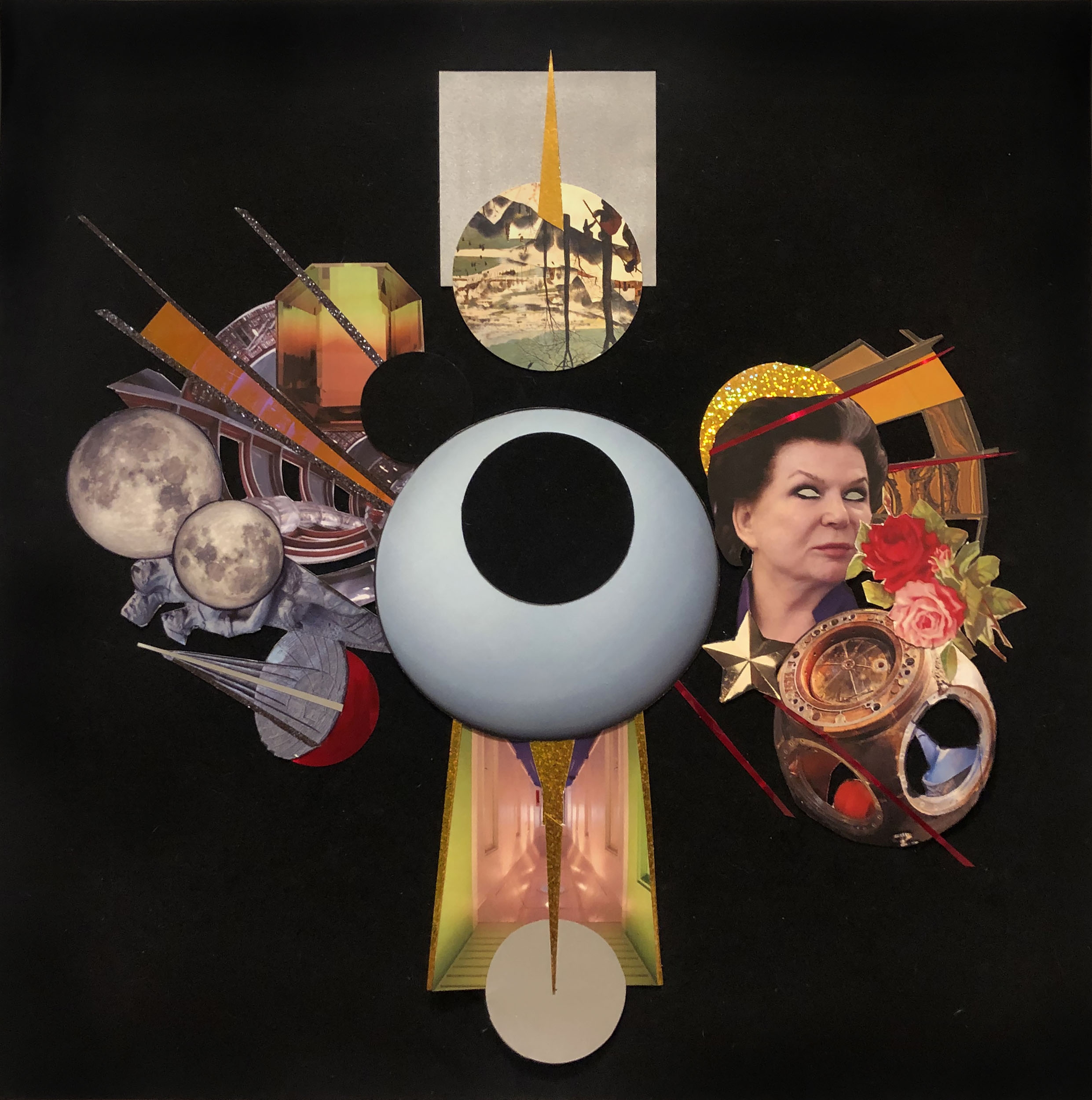
Andréa Stanislav, ‘Zero Gravity III’, 50 cm x 50 cm, digital prints, refractive film on velvet
How does the Cold War space race of yesterday influence the new space race of today which is driven by economy rather than politics?
SW: Thinking about the Cold War Space Race we tend to forget that in a way it was a military operation. After years the scientific or adventurous aspects of the story gets in front. While looking at current space exploration projects one could take a lesson from the past and be critical towards the real objectives of the programmes – because as we know science was not really the main objective of the whole endeavour. One can see clearly that even so big the space is divided into a zone of influences, slowly it starts to remind the way that Antarctica is divided, where the global powers compete between them to obtain or block access to the resources.
It is also interesting to look at the visual side of the current space programmes. Good example is the Space X Dragon and Starliner – a competitive project by Boeing. One of the most widely discussed aspects of the missions (besides technical differences) were the newly designed space suits. Boeing was criticized for making the space suits look ordinary, they were not much different than the regular, recently used suits by NASA. Space X on the other hand developed a completely new set of suits, as if someone would have picked them from a set of Star Trek. I think this relatively small in the larger perspective of the complexity of the mission detail is interesting as it shows that if we want something to look futuristic we have to make it look retro, as we are not able to imagine something really new.
MV: Also, with business corporations joining the space development programs and turning the space into a privatized industry the very idea behind space exploration shifted. It looks less and less like a global scientific and ideological project aimed at benefiting the whole humanity, it rather serves the interests of extremely wealthy people like Elon Musk or Jeff Bezos, whose business is built on exploiting the working class across the planet. So, here we can speak of a different criteria of exclusion from the future and creating privilege. If during the Cold War, ethnic and racial minorities were excluded from participation in the space race, now the space visions are designed to protect the financial power and enhance political influence of the new generation of capitalist space colonizers, allowing a very small and privileged group of people to gain from further space exploration.

‘Off to Space: Countenarrating the Cosmos’, Israeli Center for Digital Art, Holon, Israel, 2020, exhibition view
In Off to Space: Counternarrating the Cosmos you focus on repressed historical and fictional narratives around the Space race. Why do you find this angle important?
MV: The Soviet discourse of space exploration served as a powerful tool for propaganda and was actively used by the state to form a national identity and pride. The formal narrative about space, as well as the policy of choosing heroes who would embody the space achievements of the USSR, was constructed in accordance with the Soviet ideology and identity politics of the time, which was racist and antisemitic. Scientists and cosmonauts of ‘wrong’ ethnicity, nationality or race would be either not allowed to represent the Soviet Union in space or were engaged into the space program on quota basis to demonstrate the illusion of class and gender equality in the Soviet Union. In this context artistic works that unveil and trace these hidden narratives are extremely important because they not only make our understanding of history more complex and multidimensional, but also re-establish the legacy of people, whose names were wiped out or omitted from the space official history, like engineer of spaceship interiors Galina Balashova, whose work has inspired the project of American artist Andréa Stanislav Zero Gravity – Nostalgia for Earth or Boris Volynov, the first halachiс Jew in space, who story is told by Yevgeniy Fiks in his project Yiddish Cosmos. Also, we don’t know much about the non-successful side of the history of space exploration and victims of various experiments. Besides, many rocket engineers, including Sergey Korolev, who launched Laika and Yuri Gagarin into space, underwent Stalinist repressions, and were put into labor camps, where they continued working and conducting research. This was hardly widely known during the Soviet period, most of this difficult past was revealed only after the collapse of the USSR when archives would open and historians and activists started to make knowledge about the Purge accessible. I really like how the theme of unknown victims, both human and non-human, behind space exploration is articulated in the video work by Masha Godovannaya Laika. The Last Flight based on found and archival footage about the launch of the first living creature to the space. The work is made in a format of a letter to the people from the dead dog, whose haunted spirit re-tells the story of her heroic deeds and martyrdom.
Cosmos long symbolized utopian ideas of relocation, movement, exodus, solution for Earthy problems. Today Cosmos doesn’t seem to be a dream but is rather an instrument. Can we speak of an alternative dream / sublime for humankind?
MV: I read that during the pandemic many people started seeing very vivid, colorful and realistic dreams. Scientists say this is caused by the global stress and very low key routine during the quarantine: unable to travel and get new experience in reality we reprogram ourselves for extracting emotions from our dreams. This might also be a way to escape from dreaded reality and relocate to a safe, imaginary world that would be an opposite to the future that expects us. There’s definitely disappointment in previous utopian futuristic projects that now feel like a trap: continuous desire for technological progress and transhumanist utopia that, as Bifo says, leads to dissociation of sensibility and intelligence, as well the Anthropocene have promoted a vision of a better world that would be a place clean of humans. Philosophers Maria Chehonadskih and Andrés Saenz De Sicilia suggest that “the self-annihilation of the human project is a symptom of tiredness and indifference”[1], when humans are considered evil by nature. This evil is produced not by nature, but by a particular kind of a society, which existence will come to an end one day. Maybe a dream of another type of a society, that would be free of systemic violence, reproduced hierarchy and repressive machines rather than humans could be something we collectively aspire to? The protests around the world against honoring colonial symbols, evolving of new ethics and attempts to reassemble the future might be the first steps towards the end of the sleep of reason.
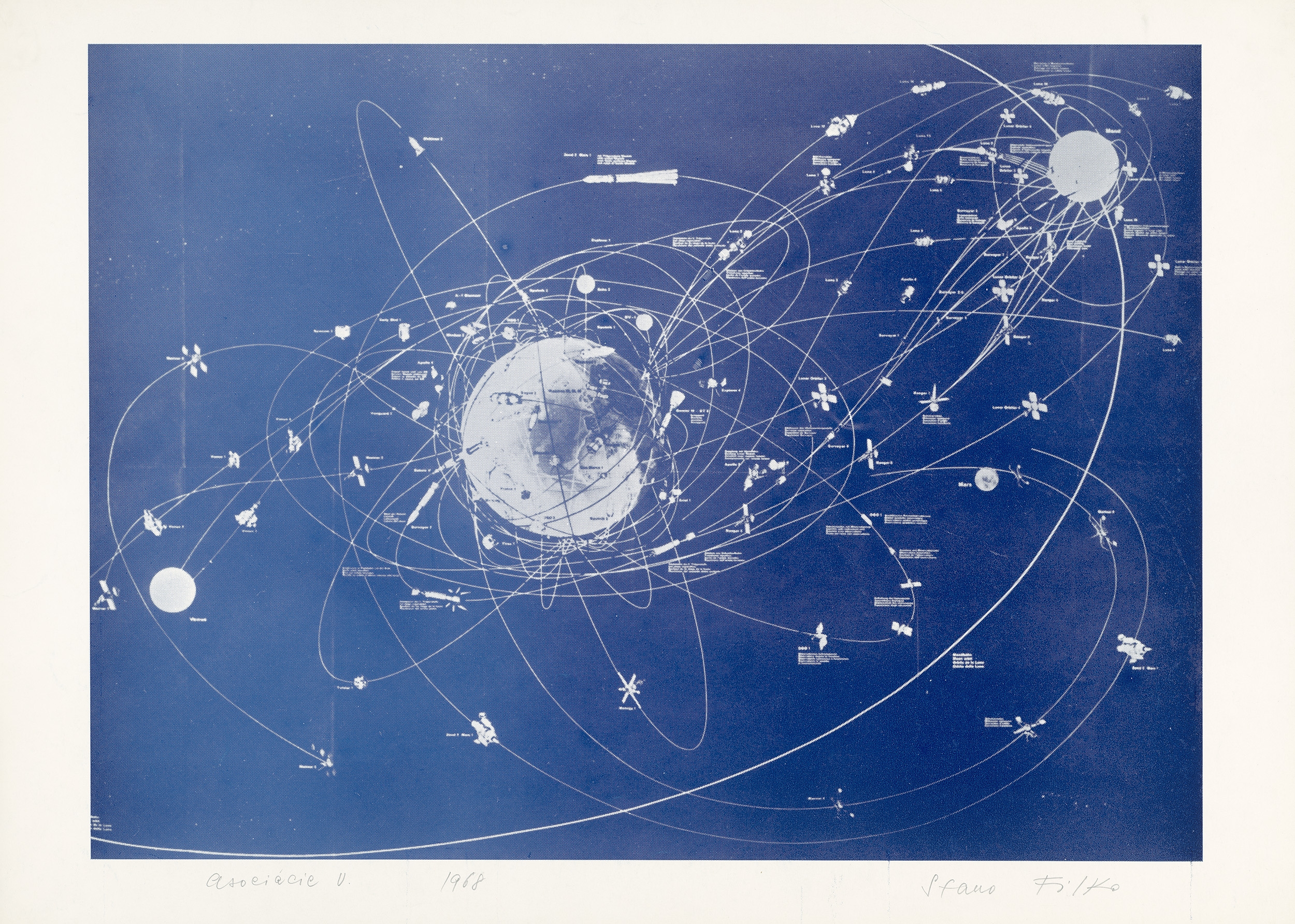
Stanislav Filko, ‘Asociácie V.’, 1968, coutesy of Slovenská Národná Galéria and Web Umenia (www.webumenia.sk)
SW: I think that one of the most interesting projects currently conducted by NASA is focused on the search for extraterrestrial life forms. In order to do so one has to ask basic questions about life itself as well as to realize that we are just a species on a piece of rock in the universe. The more lifeforms we detect on Earth in the places that we thought were impossible for any organic lifeform to exist, the larger knowledge we have on the possibilities of completely other Biosystems and organic materials the more we understand life us such. It won’t solve the Earth problems but it might give the right perspective to see humans as just another complex organic form of life. In a way it is similar to the impressions after the first photos of Earth taken from the Space were sent back on Earth, when we were able to see the Blue Marble on the black background of the endless space….
You said that during the time of the lockdown you had watched several recent sci-fi films, mostly dystopian. How do the utopias of the 1960s looks today?
SW: It was somehow a collective experience and many people reacted to the lockdown stress and uncertainty that way. I focused primarily on the recent productions, and I realized that most of the films I watched are really very pessimistic. That this is the most common denominator among them. I found that many movies or TV series actually remind me of a lot of productions from the Cold War. Mostly from the 50-s and 60-s. The parallel is here that the productions are inspired by the collective fear. During the Cold War, it would be: nuclear bombs, communists, imperialists or alien invasion now it will be rather late capitalist which lead to total destruction of the environment, lack of natural resources, new diseases caused by the environmental crisis. I think most interesting sci-fi is currently being produced by Korean or Chinese film industry, which has no baggage in rooting science fiction in the historical context of the Space Race. The biggest difference – of course it is a great generalization – is that most of the current sci-fi (not fantasy) production offer visions that do not lead to any change, it ends either with total annihilation or if the film has a “happy end” it ends where it started, in so-called back to normal. This is very depressing compared to many films from the past which often had an open ending, leading to something unexpected, to a change. One can see it in an example of Ikarie XB1 by Jindřich Polák a Czechoslovak movie from 1963 based loosely on Stanislaw’s Lem novel. The film had two versions, for the Eastern Bloc and for the West. The first one ended in Astronauts discovering a new civilization in Alpha Centauri Galaxy, while the American version had a changed and edited ending sequence – it ended with a plot twist and the astronauts discovering civilization on Earth (they literally see Manhattan from the Space). Even though the versions are from around the same time, it explains well the difference in most of the current sci-fi production (which will be similar to the Americanized version of the original Czechoslovak film). It ends in a loop, with the bleak realization that there is nothing else and no way out. One can compare this ending to the famous last scene from the Planet of the Apes (1968), when the Statue of Liberty is being discovered at the beach, at this moment we know that the Planet of the Apes is actually Earth. I think that this style of thinking is significant; it doesn’t show the limit of imagination but it transmits a powerful message of disillusion and lack of hope. It is also significant for the whole genre of new sci-fi movies which are happening in the past, I mean in the past that never was, like Space Station 76 (2014) for example.
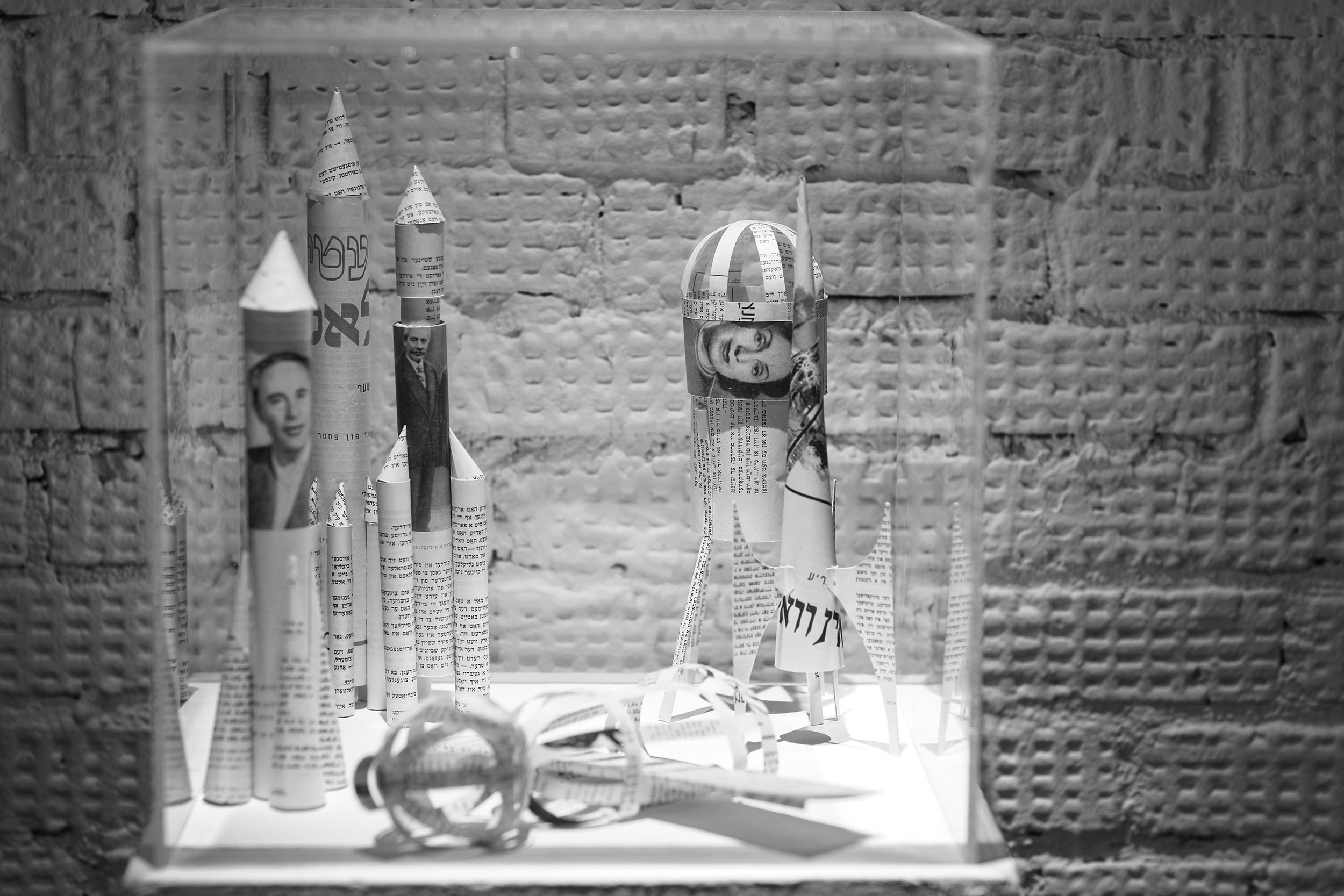
Yevgeniy Fiks, ‘Yiddish Cosmos’, Fabrica CCI, Moscow, 2019, curated by Maria Veits, exhibition detail. Photo: Oded Comay
The history of space exploration is a powerful tool in both Western and Eastern propaganda, in which each side emphasizes its achievements. How does the Space Race look from a perspective of a culture which doesn’t so clearly fit to any of these sides, for example, Northern Europe or the Middle East?
MV: Post-Soviet/US space race discourse is rather one-sided: we know very little about space programs that were happening in other parts of the world, mainly because they didn’t develop into competitive players and appeared to be erased from the public memory. For instance, in Finland the Space Program began to develop in 1959, a year after NASA. The story of Finnish Astronautical Society that started as a high-flying dream and later shrank to a male club of rocket modeling, has been explored by artist Axel Straschnoy who researches the Finnish futurism and the futuristic ambitions of post-war Finland. In the Middle East there were also attempts to develop its own space initiative: in 1960 Lebanese Rocket Society was initiated in the Haigazian College in Beirut. It produced the first rockets of the Arab World, which were capable of suborbital flight. For the region, the Space program could be both an integrative political element between the Arab countries and a major scientific experiment – in 1962 the Society received state funding and was also contacted by the Lebanese military to develop weapons. However, the program ended with the Arab defeat in 1967. This project totally disappeared from individual and collective memory and in 2009 Lebanese artists and filmmakers Joana Hadjithomas and Khalil Joreige started researching this forgotten part of the Lebanese history, which resulted in a film, and a sculpture of the Cedar 4, the rocket commemorated on a state stamp. Installed at the campus of the now Haigazian University it serves as a monument to this bold scientific experiment and a reminder of the Lebanese dream about space. At the same time, the artists present it not as a nostalgic gesture, but rather an attempt to reimagine the history and the future of Lebanon by planting an element from the past into the contemporary ground. In the Middle East the space theme lands on the complex geopolitical context, and often deals with the themes of occupation and dispossession, especially when it comes to Israeli-Palestinian relations, which some artists explore using the lens of Arabfuturism and imagining alternative future scenarios for Palestine. Breaking through when they were made, today, in the light of 2020 Israeli annexation plan, works of Palestinian artist Larissa Sansour that tackle issues of deterritoriality, heritage and national identity gain new layer of relevance. Her trilogy A Space Exodus (2008), Nation Estate (2012) and In the Future They Ate from the Finest Porcelain (2015) offer strategies of reclaiming the past and the future through resistance to established geopolitical and historical narratives and archaeological tracing of belonging and legacy of Palestinians. Placing in the center of these works a female protagonist, Larissa also challenges the traditional gender scheme embedded into both sci-fi genre and political structures and institutions, where men have had leading positions for centuries, and envisions the future from a women’s perspective.

Mona Benyamin, ‘Moonscape’, 2020, video, 22 min, video still
I also follow with great interest a Palestinian artist Mona Benyamin and her work-in-progress Moonscape, where she explores the connection of hope, nostalgia and despair by tracing the story and mission of the Lunar Embassy, a company that sells land on the Moon and grants the buyers Lunar Passports. The Lunar Embassy was established by Dennis M. Hope, who had claimed ownership of the Moon in 1980 by finding a loophole in the Outer Space Treaty of 1967 – the same year that Israel carried out a second wave of expulsions of Palestinians from their homeland during and after the war. Disguised as a music video, Moonscape is a combination of Benyamin’s personal story, contemporary politics, Email correspondences with representatives of the Lunar Embassy and reenactments of scenes from the Arab pop world.
The exhibition opened just before the brake of global pandemic and the recent wave of Black Lives Matter protests as well? How do you see your exhibition now when in the world that changed so drastically in the recent few weeks?
MV: I think the exhibition in general has become more relevant: many of the works address the time, when the concept of the future as a sociopolitical project and cognitive concept was very deeply rooted in collective thinking and promoted through channels of education and propaganda. In the today’s state of futurelessness and confusion, it’s interesting to reflect upon the question about how we have arrived to the current situation of disappointment and revisit humanity’s wrong choices and decisions, also in the field of space exploration, global digital control and militarization.
Also, the work Black Space Agency (2018) by the Black Quantum Futurism resonates with the recent wave of Black Lives Matter protests following the death of George Floyd. The work is centered around the resistance of the Black Community in North Philly during the 1960’s against the space race and its racist implications. Moon landing and other expensive NASA programs were condemned by the Black communities because of ignoring the lack of affordable housing and growing poverty. Much of this Black resistance and involvement has been erased from the popular memory and the Black Space Agency claims the place of these events in the American historical narrative connecting the past with the present and future(s) of US Black communities. The connection between resistance Black movement of the 1960s and Black Lives Matters that emerged as a new layer of the exhibition in May 2020 raises the issue of race-based privilege and calls for proactive mechanisms for breaking social reproduction of violence.

Black Quantum Futurism, ‘Black Space Agency’, 2018 at ‘Off to Space: Counternarrating the Cosmos’, curator: Maria Veits, Israeli Center for Digital Art, 2020, installation view. Photo: Shir Comay
I think this work is also relatable to the processes in the Israeli society, which is hierarchical and where racism is a problem. The Israeli Center for Digital Art is located in Jessy Cohen, a neighborhood in the city of Holon near Tel Aviv, that has a reputation of a ‘problematic’ area. There are mostly project buildings and many aren’t in a good shape. The issue of housing is an extremely difficult one in Israel – affordable housing is hardly accessible and the standards of available apartments are far from being high. There’s a lot of mass typical architecture and many cities look alike, new or renovated apartments are expensive and housing definitely is an important factor in the growing segregation within the society, like in many places across the world today. Jessy Cohen is a mixed neighborhood with poor infrastructure, where a lot of residents have a migrant background, mostly Soviet/post-Soviet or Ethiopian, and their life opportunities and access to the social resources are much more limited than those of their peers from posh areas of Tel Aviv. From this perspective, the situation in 1960s black neighborhoods of Philadelphia echoes in contemporary Holon.
Stas, you have done a very thorough research of Cold War sci-fi of the Poland, Czechoslovakia and other countries that were a part of the Socialist bloc. Have you come across any counternarratives to the Soviet ideological discourse?
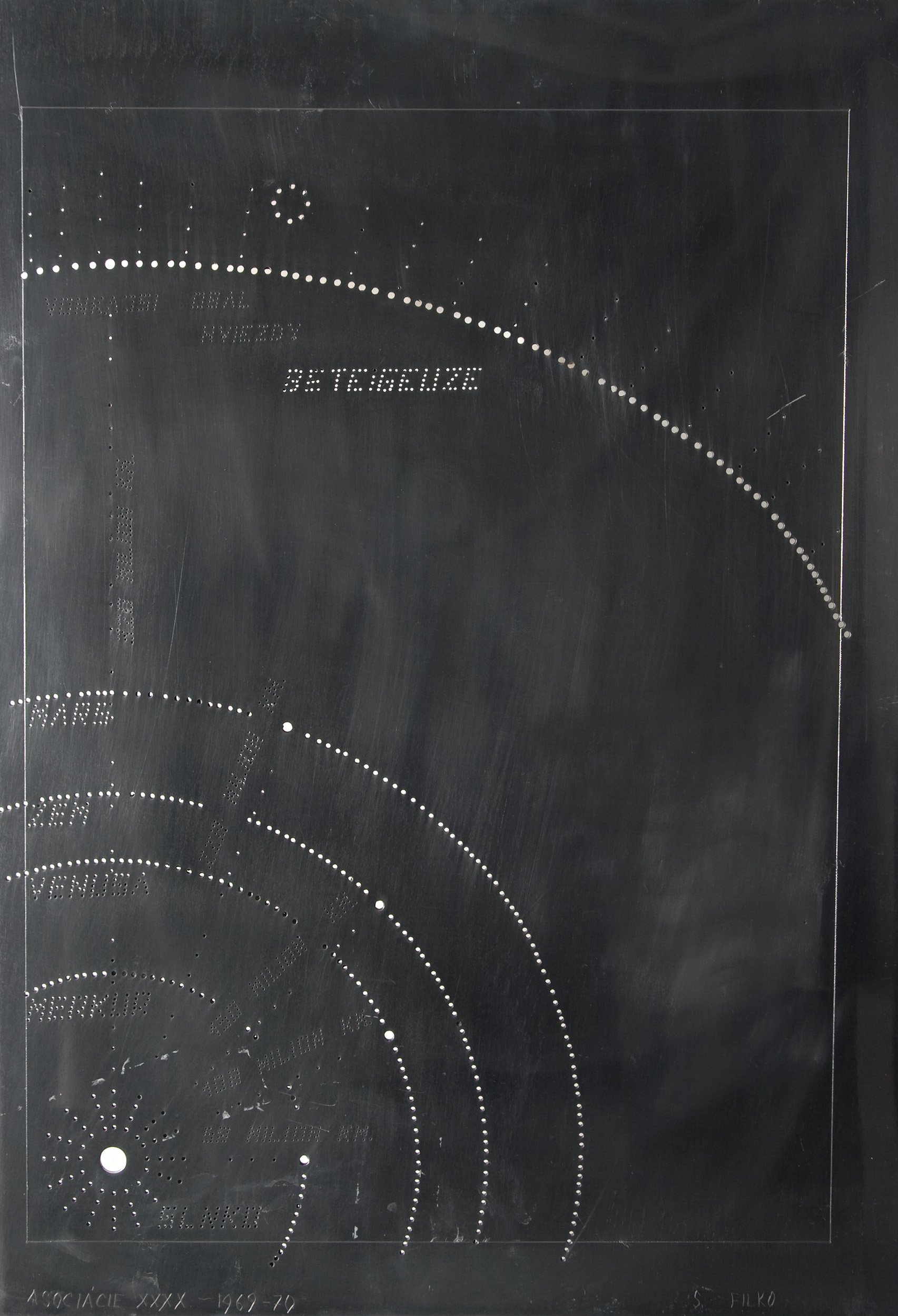
Stanislav Filko, ‘Asociácie XXXX.’, 1969–1970, coutesy of Slovenská Národná Galéria and Web Umenia (www.webumenia.sk)
SW: Yes, of course. In many cases especially in visual art the narrative on cosmos was very different from the official propaganda. For the Cosmos Calling! exhibition I conducted an extensive research in Poland, former Czechoslovakia and the GDR. The most striking similarity of what Cosmos used to be during the Cold War in Eastern Bloc is that many artists treated the Space as a place outside the current political affairs. This ‘quality’ of cosmos was attractive for artists living under socialism, as it offered neutral ground for conceptual art. The fact that the Space Race was so present in the official discourse made it a sign of certain times, the feeling of that times was very present in the art – here one could mention texts published in 1961 by two theoreticians and art critics of contemporary art of that times, or curators, as we would say today – Jerzy Ludwiński Sztuka Epoki Lotów Kosmicznych (Art of the Space Flights Era) and Janusz Bogucki Jakie znaczenie dla sztuki mogą mieć loty kosmiczne? (What meaning for art the space flight might have?).
One of important counternarratives was inspired by the very new and fresh sensations experienced and shared by the first cosmonauts – the state of weightlessness, different gravity, the extreme g- force experienced during the flight, the lack of clear direction and the emptiness of the space. Those sensations were very similar to psychedelic experience, as a way of crossing the limitations of the body and mind. The space flight in that sense is not only a political success, a sign of power of technology and state, but it becomes to be a liberating and spiritual experience. Such counternarration is in line with the interests of counterculture in new spiritual experiences, psychedelics and experiments with drugs and expanding the perception.
For artists such as Július Koller or Stano Filko from former Czechoslovakia, Cosmos was a utopian space. A refugium, a safe zone, free of propaganda and bigger than current political affairs. Is it still so?
MV: Some of the works in the exhibition explore the utopian and refuge potential of Cosmos. In Driant Zeneli’s It Would Not Be Possible To Leave The Planet Earth Unless Gravity Existed the abandoned plant Metalurgjiku, a remnant of Albanian toxic industrial past, looks like an archaeological site or a futuristic Sci-Fi city after an apocalypse. The video’s protagonist, Mario, is looking for a possibility to escape to the outer space from the industrial and political ruins of the site that used to represent a utopian communist Albanian society and a megalomaniac economic dream. Assembling an aircraft from the remnants found at the former plant, he aspires to the unknown future, a utopian dreamland that he has been longing for. Space is also represented as a safe zone and the only refugium available in the project Yiddish Cosmos by Yevgeniy Fiks, where he revisits the Soviet space program through the lens of the history of Soviet Jewry in the time of state antisemitism. Mixing facts and fiction, Fiks created a utopian idea of Yiddish, Jewish cosmos, where space was an epitome of unachievable homeland in the situation when Jews were not allowed to immigrate from the Soviet Union and fought for the freedom of movement. Axel Straschnoy also addresses the ideas of escapism and alternative realities but from a different angle – in his video work they are appear through rituals and practices of the members of the Finnish Astronautical Society, who build and launch rocket models into the sky for a hobby. The shared passion and dedication of the participants to their ceremonies also creates some kind of a safe space for them a parallel world, where childhood dreams come true.

Július Koller, ‘Univerzálna Faktografická Orientácia’, 1975, coutesy of Slovenská Národná Galéria and Web Umenia (www.webumenia.sk)
Since 2014, when you curated Cosmos Calling! the world has gone through a series of transformations on many levels. If you were curating the exhibition now, would you change anything about it?
SW: I curated Cosmos Calling! together with Joanna Kordjak and we worked on the research together as well. Actually, the changes started to occur during the research phase. We planned initially to make it as a collaborative project with other galleries and museums in the former Eastern Bloc. We started research and collaboration in Hungary but then suddenly the political changes in Hungary started to happen very fast, the institutions were dismantled and all projects stopped. We scaled down the project and presented it in Poland and focused mainly on Poland, Czechoslovakia and GDR. The research we started in Hungary is something that I would sometime go back to and develop more.
In addition to the current political changes, also very fast and radical ones in Poland the Cosmos also changed. I think doing the exhibition now I would include parts of the research I conducted later – in the archives of education and propaganda films. I think a strong point of the show was combining conceptual, avant garde art and visual culture in a broad sense – computers, stage design for sci-fi movies of that era etc… I think I would explore this even more as since it offers a lot of interesting parallels to our situation.
As a curator, I like to revisit past project and see what can be said or done more on that topic. Actually, currently I am working on a show, with Daniel Malone which is a continuation of an exhibition we presented 2 years ago in New York – How to Make a Monument (Dis)appear. It was focused on the issues around post socialist monuments in Poland and confederate monuments in the US. A lot changed in the recent times around that topic, and it is interesting to revisit it for a project which is coming in October this year in Gdansk.
As for Cosmos Calling! I feel that I am constantly working and broadening the research anyway, I am filling the gaps we were not able to present at the exhibition at that time and looking at it from different perspectives. The more you know the more you realize what was missing. For some time already, I’m planning with Yevgeniy Fiks to present in Warsaw his project Yiddish Cosmos.

Yevegniy Fiks, ‘Yiddish Cosmos’, 2017 at ‘Off to Space: Counternarrating the Cosmos’, curator: Maria Veits, Israeli Center for Digital Art, 2020. Installation view. Photo: Shir Comay
What kind of a vision of the future emerges from looking on the archaeology of the space race? And does your personal experience influence the way you see and perceive the Cosmos?
SW: When retelling the story of the Space Race and creating a counter narrative of Cosmos we face the past visions of future. As we know now – most of the futuristic visions of Space exploration as a catalyst for a new and better society were never realized, moreover the Future as such seems to be a “cancelled” project. That is why this confrontation is a crucial one – it enables us to see clearly not only the global balance of power and its ties to economy and politics but also a structural and systematic discrimination – racial, gender, class etc. – which lead to such a pessimistic or even a bleak perspective. Looking at the past and in the same time trying to rethink the future can inspire one to find a way out of the stalemate. I hope that by revisiting the narrative of underrepresented people and communities and attempting to make them visible and recognized we can change how we see not only the past but the present. Thinking about Space gives also a right perspective on Earth and the ongoing environmental crisis. I hope that in a way it can liberate the idea of Cosmos, to emphasize that the future doesn’t belong to any state, company, corporation or start-up. It’s difficult in the times when private satellites sent in amounts never seen before are polluting the sky and blurring the vision of the stars…
MV: This archeological exercise has been very useful for me as a curator because it allowed me to merge into a multitude of multivocal narratives and reframe and expand my vision of many events set in the past as well as create new connections between them, the contemporary moment and the future. I think that artistic strategies of reviewing contested and silenced past offer an important range of tools to question our preset vision of history and challenge the linearity of time and the historical continuum. I feel like the pandemic and the following political and economic developments it has instigated, has largely affected our perception of time and brought new bodily experiences including isolation, deprivation of touch and limited movement – something that astronauts experience a lot. This state of physical and emotional limbo, when real communication is minimized and virtual conversations become highly important and politically charged, is a good moment to train our political imaginary and expand our set of future-related visions. It seems that in order to carry on, we must collectively reimagine the social order and revisit the concepts of inclusion, responsibility, care anew and calibrate the shared lens of looking at each other and the future we may shape.
[1] Maria Chehonadskih and Andrés Saenz De Sicilia, “Subject: The Global Distribution of the Ethical”, https://ccworld.hkw.de/the-global-distribution-of-the-ethical/
Imprint
| Index | Maria Veits Stanisław Welbel |
